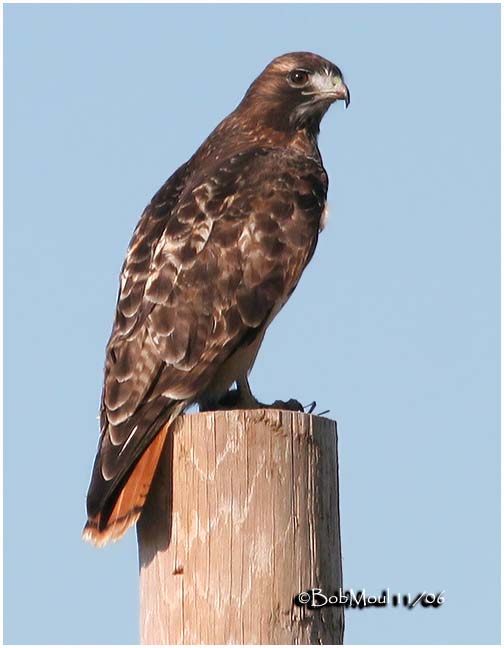
Red-tailed Hawk
Buteo jamaicensis
Accipitriforme Order – Accipitridae Family
BIOMETRICS:
Length: 45-65 cm
Wingspan: 114-133 cm
Weight: 690-1460 g
LONGEVITY: up to 22 years
DESCRIPTION:
Red-tailed Hawk adult has a rufous-coloured tail, with black narrow terminal bars. But it may not have these bars. Wings are long and broad.

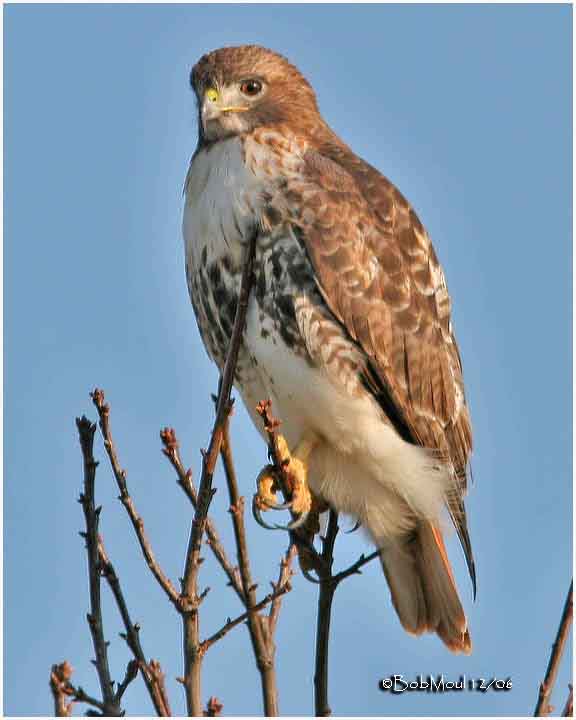
Adult has dark brown back and top of wings. Its plumage is variable from light reddish-brown to dark brown. Underparts are lighter than upper. Lower belly is paler than the rest of the body, with a dark band across it. Tail is uniformly reddish, giving red-tailed hawk its name. Tail is broad.
Bill is short, hocked with yellow cere, and black tip. Eyes are dark brown. Legs and feet are yellow.
Female is 25% larger than male, but their plumage are similar.
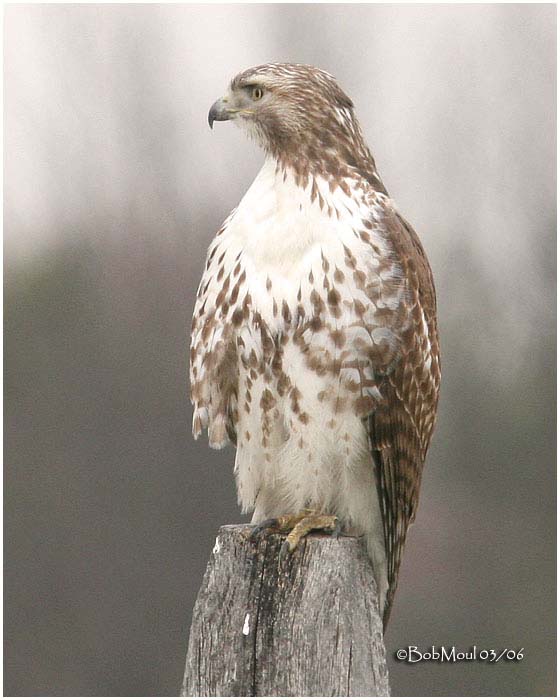
Immature is similar to adults, with paler eyes. It is more streaked, with brown tail, barred by several dark bars.
We can found two morphs: light morph and dark morph, and at least 14 subspecies, with large differences in plumage and range.
VOICE: SOUNDS BY XENO-CANTO
Red-tailed Hawk’s call is a horse raspy and scraping 2 to 3 seconds scream “keeeear”. This call varies with age and range of the bird. It is often heard while soaring.
Young birds utter some soft and low “peep” sounds, becoming deeper with the age. When parents leave the nest, young have a loud wailing “klee-uk” repeated, asking for food.
HABITAT:
Red-tailed Hawk lives in grassland or shrubby marshes, but also in deserts and forests, from sea level to variable heights, but near the edge of a stream, a lake or a field.
RANGE:
Red-tailed Hawk breeds from Alaska to Labrador, and southwards, to Mexico, Bahamas, Caribbean and Central America.
It winters from southern Canada southwards.
Northern birds migrate south in winter, but many other birds are year round residents.
BEHAVIOUR:
Red-tailed Hawk hunts with variable methods, and captures all kind of preys. Generally, it sits on a pole or a high perch, and swoops down on the prey. But it may also hunt while flying, looking on the ground with its keen eyesight, allowing it to detects movements at great distances. It may detect a mouse from 100 metres high.
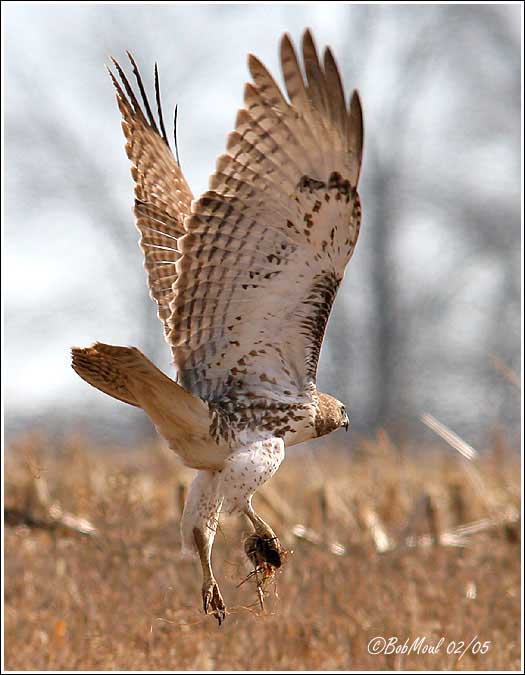
It uses its strong talons as weapons. It may also hover in strong winds, searching for prey on the ground. Red-tailed hawk is active during the day. Small preys are carried on the perch, while large preys are usually eaten on the ground.
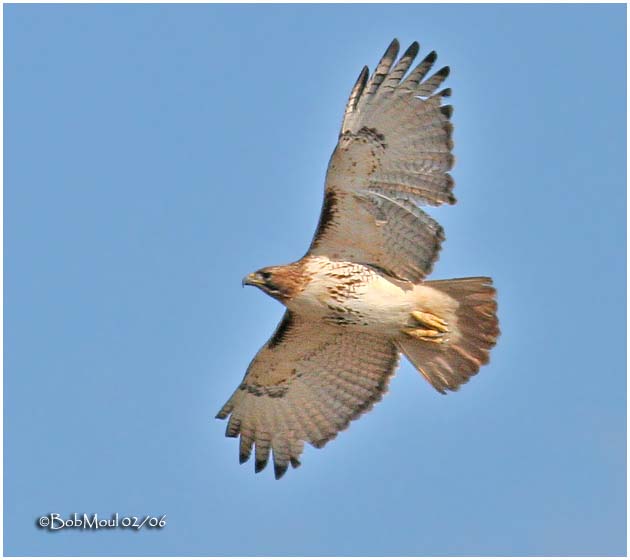
During courtship display, pair soars in wide circles, uttering shrill cries, at great height. The male dives in a steep drop, then it climbs again, repeating this display several times, and at the end, it approaches the female from above, extends its legs to grasp briefly the female talons. Then, they spiral towards the ground.
Male may catch a prey and pass it to the female in flight. Pair copulates after these displays, landed on a perch, preening each other, and then female allows the male to mount her.
Red-tailed Hawks, as other animals, have body language. Aggressive posture, with held body and head, and erected feathers; submission posture, with lower head and smooth feathers; aerial behaviour during courtship display; undulating flights and dive-display, used in territorial displays.
Red-tailed Hawk mates for life. They are territorial birds, defending aggressively their territory, female close the nest site, and male over their territory.
FLIGHT:
Red-tailed Hawk has an agile and strong flight, performing acrobatic flight displays. It is a high flier hawk. It soars effortless with wings held in a shallow V. It is an active flier, flying with a lot of flapping wings.
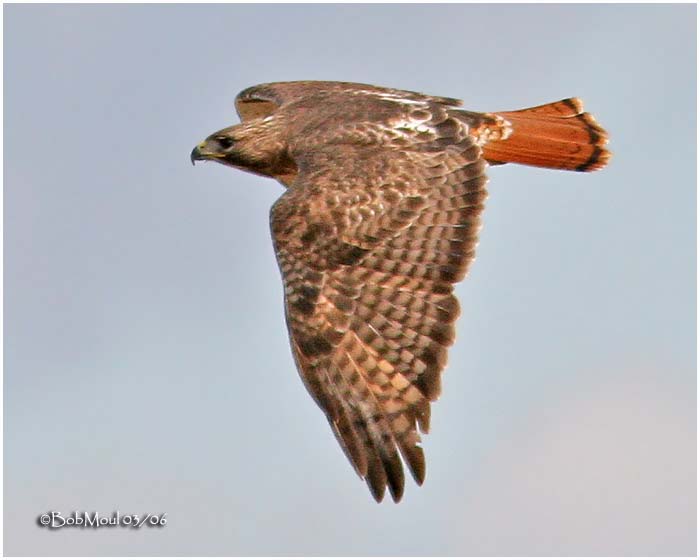
REPRODUCTION:
Red-tailed Hawk’s nest is a large bulky bowl, made with twigs, barks and leaves, high in a tree or a cliff. It may be used year after year. Nest is built by both adults. Fresh materials (pine needles and green plants materials) are added into the nest during the breeding season, to keep it clean.
Female lays 1 to 5 white or white bluish eggs, variably spotted with pale brown. Incubation lasts about 28 to 35 days, by both parents, more by female which is fed by the male bringing food at nest.
Young hatch altricial. They are covered with white down, and they grow slowly.
During the nesting period, female broods the chicks, and the male feeds young and female. Female feeds the chicks with small pieces of preys brought by the male at nest.
Chicks may leave the nest at about 42 to 46 days, but they fledge during a period lasting up to 10 weeks, time to learn to fly and hunt.
Young reach their sexual maturity at about 3 years. This species produces only one clutch per season.

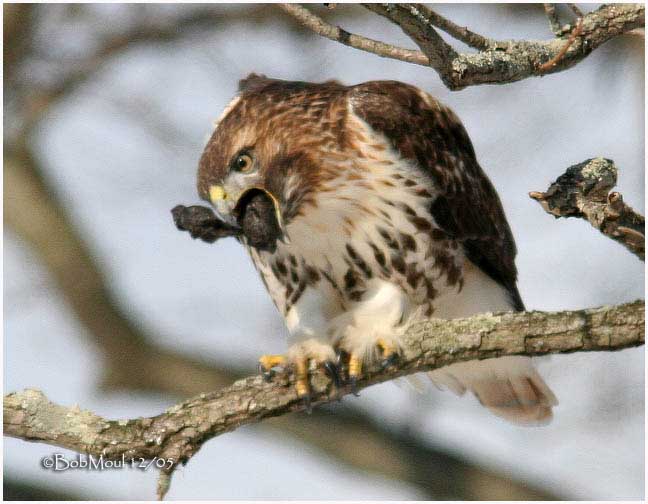
DIET:
Red–tailed Hawk feeds mainly on mammals (mice, rats, squirrels, muskrats, weasels), birds (ducks, pigeons, rails, doves, woodpeckers, pheasants, crows, and rarely poultry), reptiles and amphibians, fishes and invertebrates.
It regurgitates pellets made with bones, fur and feathers.
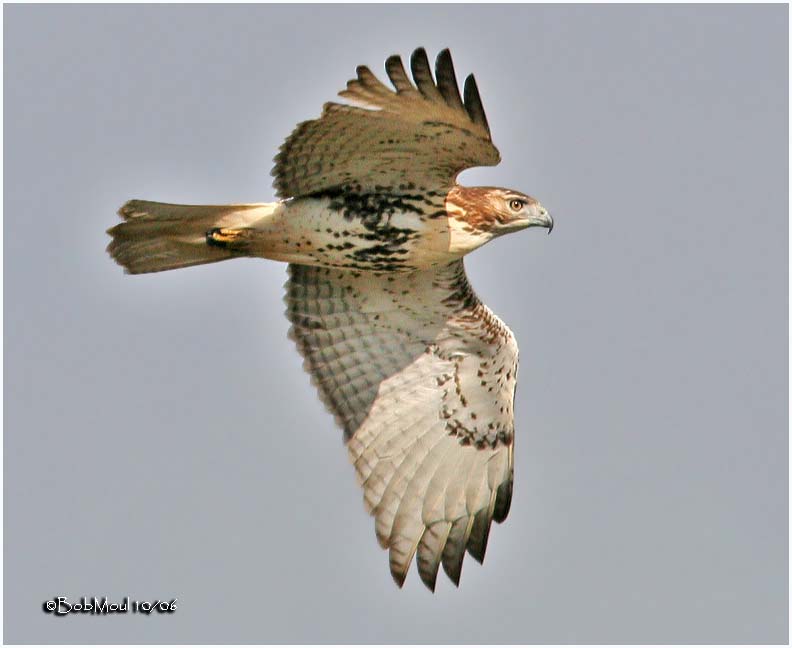
PROTECTION / THREATS / STATUS:
Red-tailed Hawk has few predators such as Great horned Owl, corvids, but also red foxes and raccoons. They eat chicks and eggs.
Red-tailed Hawk is threatened by shootings, collisions, habitat loss and human disturbances during nesting period. Lead poisoning also kills several birds every year.
Fr: Buse à queue rousse
All : Rotschwanzbussard
Esp: Busardo Colirrojo
Ital: Poiana della Giamaica
Nd: Roodstaartbuizerd
Russe: Канюк ямайский или краснохвостый
Sd: Rödstjärtad vråk
Photographs by Bob Moul
His website:
Nature Photography
Text by Nicole Bouglouan
Sources :
FIELD GUIDE TO THE BIRDS OF NORTH AMERICA - National Geographic Society - ISBN: 0792274512
A GUIDE TO THE BIRDS OF MEXICO AND NORTHERN CENTRAL AMERICA by Steve N. G. Howell, Sophie Webb - Oxford University Press - ISBN: 0198540124
HAWKS, EAGLES AND FALCONS OF NORTH AMERICA by Paul A. Johnsgard - Smithsonian Institution Press - ISBN: 1560989467
BIRDS OF THE GREAT BASIN – by Fred A. Ryser - Univ of Nevada Pr -ISBN: 0874170796
All About Birds (Cornell Lab of Ornithology)
Animal Diversity Web (University of Michigan Museum of Zoology)
The Hawk Conservancy Trust (Hilary Smith)
What Bird-The ultimate Bird Guide (Mitchell Waite)
Wikipedia (Wikipedia, The Free Encyclopedia)